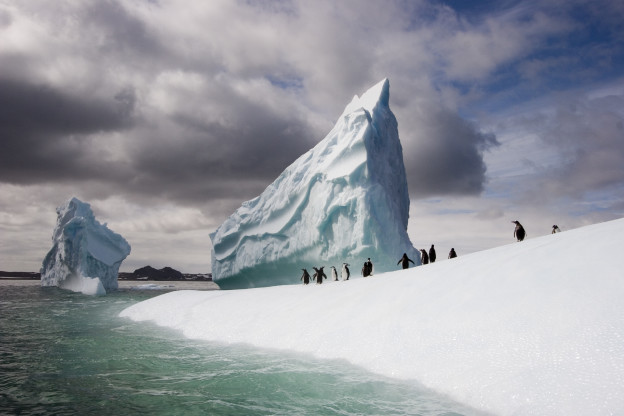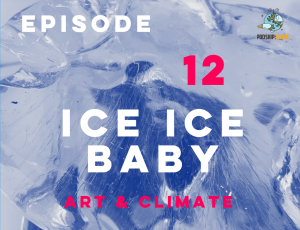I was honored to be featured on the 12th episode of Podship:Earth, May 2018, in which Jared Blumenfeld explores the intersection of climate and art… and ice. It was an expansive and great conversation.
Category Archives: Featured

StoryCorps Interview
Excerpts from interview at the StoryCorp booth for the Human Impacts Institute, San Francisco Public Library, November 2014.

Through the Eyes of a Climate Artist
Artist statement for Mountain Film in Telluride, 2014. by Carter Brooks
During the late 1990s, while my brother, Cameron, was assistant director of Mountainfilm, I was a regular. So I’m excited to return after more than a decade’s hiatus, and it’s fortuitous that the word in the air this year is “wilderness.” Cameron wrote his senior college paper on the Wilderness Act, perhaps inspired by a class we both took with the legendary philosopher-turned-environmental-historian Bill Cronon. Cronon taught us how our mental concept of wilderness and nature affected how we manifest ourselves on the landscape, whether we were conscious of it or not.
The year was 1988, and climate change wasn’t yet on my radar. In fact, it was just stepping onto the public stage. The IPCC was formed that year, and Jim Hansen gave his now-historical first testimony on climate change before the U.S. Senate. A year later, Bill McKibben published the first book on the subject for the general public, The End of Nature, in which he pointed out the surreal realization that an untouched nature wasn’t possible anymore, now that we’ve changed the air.
In the intervening years, things have, well, changed. Last year, just a few weeks before my twenty-fifth reunion, CO2 concentrations in our atmosphere passed 400 ppm. We’ve set the atmosphere back 2 million plus years to a different geologic epoch. We talk daily and matter of factly about the ice cap melting and measuring carbon footprints, while bemoaning humanity’s tendency not to take action until the consequences are obvious — when they are dire and already upon us.
Echos of Cronon’s class are as relevant as ever when it comes to climate change, not just for the profound challenge to our idea of nature it implies, but also because those ideas shape our response. Perhaps this is seen most clearly in the way our concept of nature as a symbol of virtue results in an incredible overemphasis on what individuals can personally, virtuously, do to “save” it. This, unfortunately, comes at the expense of focusing on systematic changes. We can see it play out in the public conversation, the vitriol of the political spat, right down to neighborly tensions over SUVs versus Priuses.
Conceptual metaphors in language unrelated to nature also shape our actions. Think about the dominant conceptual metaphor: “Change is motion.” We speak of climate change as “speeding up,” having “momentum,” and are even so bold as to suggest the goal is to “stop” climate change. For substantial natural changes a big rolling boulder comes to mind. Our general call for mass behaviour change is, in a way, an organizational principle that is a natural entailment of this metaphor. We can conceive of “stopping” climate change because we can imagine the boulder coming to rest.
The truth, I daresay, is more complex — a bit more sobering, too. A better metaphor might be a big wave. In fact, truly wrapping our head around it may require taking the advice of the great Donella Meadows to “be unattached in the arena of paradigms.” She was speaking about leverage points in systems. But I think what she was getting at was that in order to see complex systems truly requires a profound act of letting go: “It is in the space of mastery over paradigms that people throw off addictions, live in constant joy, bring down empires, get locked up or burned at the stake or crucified or shot, and have impacts that last for millennia.” And isn’t that the current challenge? To have an impact on the situation on a millennial scale?
One of the roles of artists is to look at things differently. So, when I, as climate artist, look at the current global event, I don’t see a “problem,” for which there are “solutions.” I think civilization has a “situation,” or, as the kindred souls at the Dark Mountain Project put it recently, a “predicament.” It doesn’t imply solutions; it implies evolution. I don’t see a bunch of individuals not changing behavior. I see a civilizational organism metabolizing the earth’s stored energy. I see hundreds of millions of years of the earth’s stored photosynthesis risen up and animated at once in the form of a sort-of-industrial meta-being. With a big sugar pile that no one can guard. That’s not a problem that can just be solved. It, perhaps, implies a different sort of response.
For this reason, I like to talk about climate art as an art and a philosophy. The art is to come at the situation from a different angle. The philosophy, well, that’s a longer conversation…
Considering wilderness at this moment may be about softening our focus on time. The wild being in me is haunted by the images David Breashears showed us years ago in the Sheridan Opera House of the Himalayan glaciers’ dramatic deflation. Living geology passing before our eyes. To find the wild in ourselves is to find the dignity of humanity from that time when the energy efficiency of our body was our advantage on the shelterless plain. With that dignity, be present and bear witness. See the eons of time dissolving into the air and melting before you, and marvel at the responsibility and excitement of being alive on the planet at this moment.
—Carter Brooks
Original Post
www.mountainfilm.org/2014/05/16/climate-change-through-the-eyes-of-a-climate-artist

What is Climate Art?
Here’s the sobering news, the climate crisis is worse than you think. Though it is often presented as a problem with a known solution, in reality, civilization is facing a dire situation with no realistic scenario that will avoid profound consequences. Consequences for civilization, and the fabric of life itself.
On top of this, the situation is from another time, literally. We have already changed the atmosphere to a composition that last existed before there were humans on the planet. The ice we are melting is millions of years old, and holds the memory of a time before humanity. The coal and oil represents half a billion years of plants storing up the sun’s energy. We have unleashed a story way older than humankind. Way, way older than civilization.
In short, we have a civilizational koan. If we are lucky, and ride this out, we will have to collectively transform into something we would not recognize today. We will have to come at it from a place beyond our current imagination. Imagine the microbes in your stomach becoming aware of the shape of the whole human body, and then initiating a transformation into a plant. That’s the order of challenge before us.
So, if we are going to bring the best of ourselves to the situation, the best of humanity to the moment, we are going to have to come at it from another time. Literally.
All of which is rather abstract and metaphysical, which is what brings us to art. Art is the realm in which we can naturally engage the abstract and discover something new. The artist is a role in society who can be taken seriously when making the abstract tangible.
Climate Art is more than just art, and creativity. It is more than just expanding awareness. More than just communicating ideas. Climate Art is the intersection of Art and the Climate Crisis, so must be about engaging the subject directly and building capacity in the qualities and talents necessary for the scale of challenge facing humanity and the planetary system as a whole. It is ambitious. The Climate Art movement has to outcompete paradigms. The Climate Art charge is to create an engagement of the situation so compelling that it simply trumps our current distractions and boxes of reality. Imagine an art movement that rivals religion and economics in defining our daily reality.
So, what are the characteristics of Climate Art? And where do we see it now?
One obvious beginning is the art of witnessing the melting of our geologic ice. The photographers and filmmakers such as James Balog, Sebastian Copeland and others, who are documenting our disappearing glaciers and landscapes of ice before they are no longer intact.
Then there is aerial artist John Quigley, who has done dozens of human sculpture images in threatened and awesome landscapes related to the climate crisis—800 Intuit on the sea ice in the Arctic, indigenous peoples in the Amazon, middle school students in the snows of Park City. The events have not only allowed people to become part of this epic story, they have the also provided the example and inspiration for global days of expression.
Another example of Climate Art is the work of Bill McKibben and 350.org, advocating for the impossible goal of divesting from the fossil fuel industry, a grand public opera if there ever was one. It is Climate Art, because it enrolls all in the story as active participants.
Other good news for Climate Art includes the growing body of “no spectator” art experiences such as Burning Man, which require participation, practicing co-creation. But, more importantly, they demonstrate that new, unpredicted realities can work, and even be more compelling than the current “default reality”.
These, however, are just the beginning threads. The promise of the Climate Art movement is to catalyze an evolution in humanity, perhaps even escaping the paradigm of civilization. It is to let go into the unknown and surprise ourselves creating impacts that last millennia. There is not time to waste.
Artist Statement
Artist Statement for Mountain Film on Tour, at the Throckmorton Theatre, November 2012.
I’ve got some sobering news… The ice is going to melt.
At the time of my daughter’s birth in 2000, the scientific forecast was that the polar ice cap would disappear by the time she reached her grandmother’s age. While climate crisis activists were running around betting on the naive long odds that a “solution” that will somehow “stop” this, I found myself more compelled by the urgency of witnessing and discovering meaning in this profound event. Why run around calling people to bail the Titanic with teacups at the expense of being present for the last breaths of the glaciers’ deflation? In the midst of all the focus on “the survival of our species,” who will cry for ice? Who will hold its hand to capture the twinkle in its eye before it closes? What stories, wisdom and qualities will go extinct with the last drips of the mountain glaciers older than civilization itself? What is the proper response to this grand aesthetic and spiritual loss? Meanwhile, how will humanity evolve through the crisis? Why are we alive on the planet during an induced geologic event? It’s a pretty exciting time to live a life. How does an individual or a species cultivate the paradoxical state of enthusiatic excited despair? I couldn’t help but decide to devote the remainder of my career to these compelling questions. But as urgent as the questions are, they are also metaphysical and abstract, which, well, brings us to art. Ice is quite simply the obvious medium for a climate artist.
So, here’s the good news… Ice is cool. And ice on metal…even cooler. Take a moment to unburden it from the profound questions. Be fascinated. Enjoy its meditative pace. Pet it. Watch it dance with light. Put it in your pocket, and go flying with it in your dreams.
— Carter Brooks
MountainFilm on Tour
Mill Valley, CA
November 2012
142throckmortontheatre.com/mountainfilm.php
mountainfilm.org/tour

